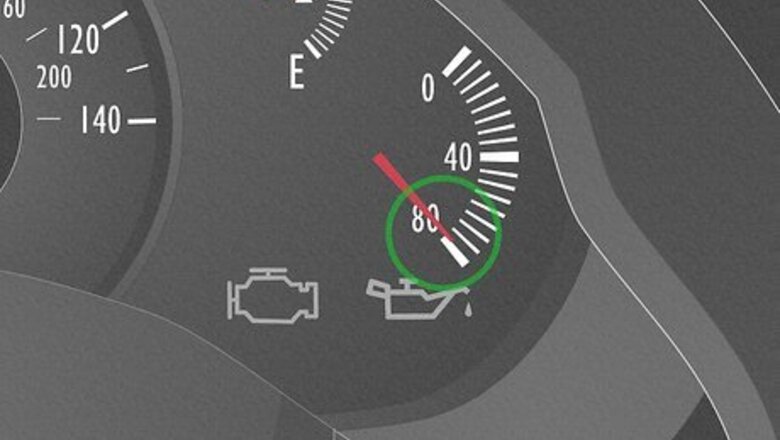
views
- If your car has high oil pressure, take it to a mechanic. They have all the equipment and experience to diagnose and repair your vehicle affordably and efficiently.
- Oil keeps your car’s engine lubricated. When oil pressure gets too high, it causes a blockage and friction in your engine.
- High oil pressure is usually caused by dirty oil filters and debris. Oil carries dirt particles like soot, dust, and sludge with it. These particles build up over time.
- Other signs of high oil pressure (that aren’t the “check oil light”) include engine sputtering, oil leakage, and a burnt oil smell.
What is high oil pressure?

High oil pressure means your car’s oil flow is clogged. Oil is responsible for keeping your car’s engine nice and lubricated so it doesn’t rub too harshly against the other precious parts of your vehicle. High oil pressure causes thick oil and debris to build up and block this flow. This buildup leads to overheating and harsh scraping between your car parts, which can lead to cracks in your engine and long-term damage to your car. Think of the oil pumps in your car like a hose. When you put your thumb on the nozzle of a hose, water still flows, but because pressure builds up behind your thumb, it comes out in uneven and ineffective spurts. Do not drive with high oil pressure. Without a properly lubricated engine, parts of your car will rub together which can damage its pressure seals or cause engine failure. And if your car experiences engine failure, not only is it expensive, it's also very dangerous.
High Oil Pressure Causes & Solutions

Contaminated oil filter The most common cause of high oil pressure is a dirty oil filter. Oil filters usually last about 3,000 miles, but as time goes on, dust, soot, and other small particles begin to collect inside. This causes buildup and your filter will need to be replaced. Solution: change your car’s oil filter. You can Replace your car’s oil filter at home by draining the old oil and lubricating the gasket, or, if you want to avoid the hassle, most auto shops will do it for about $35-75 (or around $125 if your car needs synthetic oil). Signs: If your car has a black or excessively dark exhaust smoke, it’s likely spewing contaminants from your dirty oil filter. Another common (and more serious) sign of a dirty filter is knocking sounds in your engine. If you hear banging in the car’s internal, pull over immediately. This means parts are starting to rub together.

Blocked oil passages As oil flows through your car, it carries debris with it. Over time, this debris (usually a combination of sludge and carbon deposit) builds up and causes a blockage in your car’s oil pathways. Solution: clean your oil passages. Remove your car’s oil pan and use a brush to scrub and scrape away all the sludge and debris. Then, rinse out the remaining contaminants with about 4 US quarts (3.8 L) of oil or warm water and re-insert. Signs: The most common sign of blocked oil passages is a sputtering engine. If you notice your speed and engine sound breaking up, it means oil is not being properly circulated due to some obstacle.
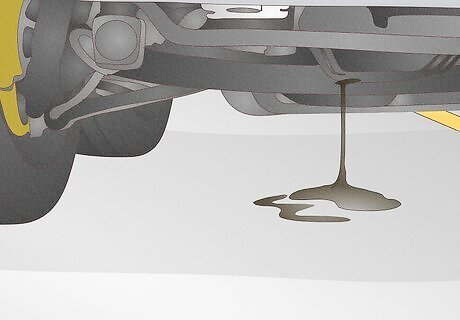
Relief valve malfunction Relief valves are like engine safe havens; they provide places for fluid to flow when the pressure gets too high. Usually, car relief valves open automatically when oil pressure reaches a certain level. However, if your relief valve has a broken spring, plug, nozzle, or it’s adjusted incorrectly, this can cause a failure, which means the oil pressure in your car will continue to build. Solution: see a mechanic. Pressure relief valves are a super intricate part of your car’s oil pump and every valve is different. Rather than gamble, it’s best to see a professional who knows exactly what part to repair or replace. Usually, a valve just malfunctions from normal wear-and-tear, and the replacement part rarely costs more than >$200. Signs: Since your car’s relief valve is meant to regulate oil pressure, any oil leakage is usually a sign of a valve malfunction.

Mismatched oil grade and viscosity Motor oil comes in varying degrees of thickness. Thinner oils do well in colder climates and circulate through your car more easily. In warm weather, the car needs a thicker oil and more pressure to flow effectively. Oils also have varying grades: synthetic, mineral, and blended. If you use an oil that’s incompatible with your engine, it can cause pressure to build and overheat. Solution: use a more efficient oil for your vehicle. Check your car’s manual and/or the API Motor Oil Guide to ensure you’re using an oil that functions well under your vehicle’s viscosity grade and performance level. Signs: If your car has a bad fuel economy (you hit empty well before the manufacturer says you’re supposed to) or has a difficult time starting in cold weather, there’s a strong chance you’re using the wrong oil.

Damaged oil pump Oil pumps are responsible for engine cooling and lubrication. If your car’s oil pump is old and its bearings (the parts that absorb the friction) are worn, it can’t properly lubricate the engine, which creates a high oil pressure condition and overheats your vehicle. Solution: check your oil pump with a pressure gauge. Before you fix your oil pump, you want to make sure it’s actually broken. Remove your oil pump from the oil pan (it’s usually near the top) and attach a pressure gauge. Compare the pressure gauge’s reading to the recommended numbers from your car’s manufacturer. If it’s too low or too high, visit an auto shop and order a replacement. Signs: Oil pumps usually need replacing about every 5 years or 12,000 miles. Since oil pumps are more intricate and directly involved with the engine, you’ll likely see a “check engine” light come on if your oil pump fails.

Defective sending unit Your car’s sending unit controls the oil gauge on your vehicle’s dashboard. If your sending unit has been damaged by high voltage, impact, a blown fuse, or false grounds, there’s a chance that your oil pressure is fine, but you’re receiving incorrect readings. Solution: get your gauge fixed by a professional. Broken sending units are inconvenient, but not dangerous. Make an appointment with a mechanic and they’ll replace it (sometimes for free, since sensors are usually covered under warranty). Signs: You won’t be able to tell if your sending unit is correct or not, unless you check your oil pressure with something else like a multimeter or test kit. However, if your “check oil light” blinks instead of turning on steadily, that’s usually a sign something is wrong with the sensor itself.
Oil Pressure Upkeep Advice

Change your car’s oil regularly (every 10,000 miles or so). To avoid issues with your car’s oil pressure altogether, do an oil check about every 6 months. If notice a problem and you’re comfortable working with cars, you can change the oil yourself by elevating your car with a car jack and draining the oil with an oil pan. Once the oil has been drained, remove the old oil filter and replace it with a new, lubricated one. Fill your new filter with appropriate oil for your car and voila! You’re ready to get back on the road again. Use your car’s dipstick to ensure your car’s new oil level is normal after replacing the filter. You’ll need a socket or crescent wrench to unscrew the old oil plug. Keep it handy in case you need help unscrewing or re-screwing the oil filters, too. You can use steel ramps to elevate your car if you don’t have a car jack.

Take your car to a mechanic annually. Take your vehicle into a trusted repair service every 12 months or so (especially if you’re unfamiliar with cars). They’ll be able to do regular diagnostics and maintenance to ensure everything is running smoothly. Plus, they’ll be able to warn you if essential parts like your oil pump or relief valve are being worn down and replace them before the situation gets inconvenient or dangerous. A general car diagnostic fee is only about $100.
How to Check for High Oil Pressure
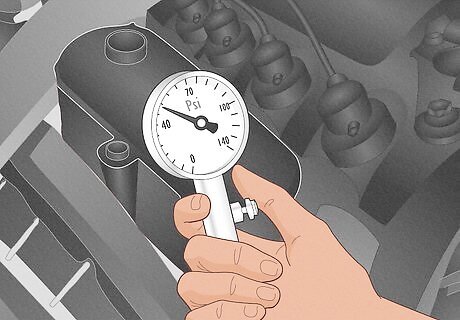
Use an oil pressure test kit. Remove your car’s oil temperature sender (a small knob in the engine block near the sump) and replace it with the appropriate adapter from your oil pressure test kit. Attach a pressure gauge to the adapter and turn the engine on to check your oil level. A low reading on your test kit usually means your car has an oil blockage or worn pump. Every car has a different reading. Use your pressure kit’s manual to determine what a good reading is for your vehicle. Check the reading on your test kit before you turn the engine on to see what the vehicle’s pressure looks like before the engine reaches operating temperature.

Analyze your oil level and clarity with a dipstick. Pop your car’s hood and pull out the dipstick (it usually has a bright circular or rectangular cap near the engine block. Then, check the level and quality of your oil by examining its fill lines and using a rag to inspect its color. The oil should look yellowish-green on the rag and it should be filled halfway between the minimum and maximum fill lines. If your car’s oil is dark brown or black, that’s a sign its oil filter is dirty and your oil needs changing. If your car’s oil goes past the maximum fill line (the line about an inch above the dip of your dipstick), odds are it’s become overheated and your pressure is high.
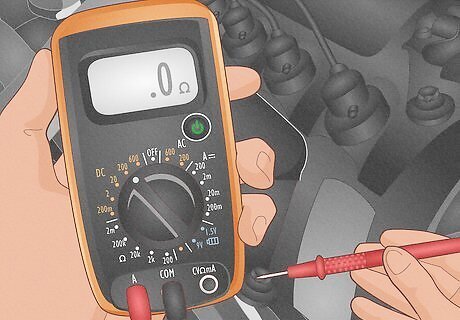
Test your oil pressure with a multimeter. A multimeter is an instrument designed to measure the voltage and resistance of a device. Use a multimeter to check your oil’s flow by turning your car off and connecting one of the multimeter leads to the warning light terminal on your car’s oil pressure sensor (usually a cylinder near your engine). Then, place a 2nd multimeter lead on the sensor housing. (It should read 0 ohms.) Once your multimeter is connected, turn your engine back on. If your oil pressure is functioning normally, the multimeter should read infinity on its display. Different cars have different oil pressure switches. If your car has multiple switches on its oil pressure sensor, simply connect the multimeter lead between both pressure switch pins to check the car’s charge and flow.
Symptoms of High Oil Pressure
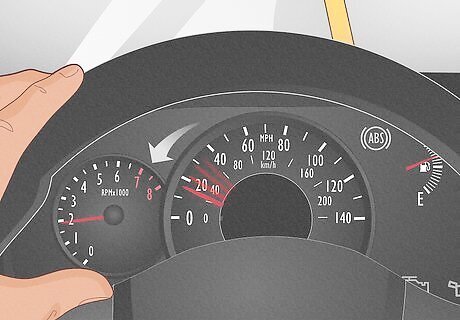
Low speed or sputtering If you floor it, but your car remains idle or your speed gradually slows down, this is a result of friction in your engine. This friction is caused by lack of lubrication (a telltale sign of high oil pressure).
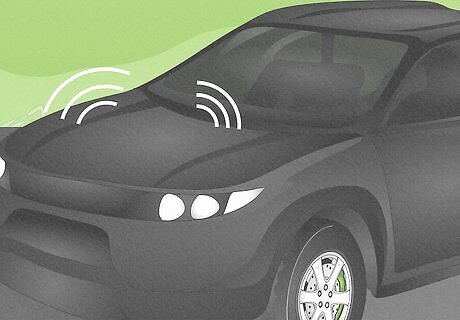
Friction sounds If you hear grinding sounds or noises of parts rubbing together, pull over immediately. This means your oil levels are low and/or there's blockage in your oil pumps. If the friction continues, it can cause permanent damage to your engine.

Burnt oil smells If you smell oil from within your car, it’s because car oil is leaking onto the hot engine or exhaust and burning a stench. This overheating/leakage is a sign of high oil pressure.
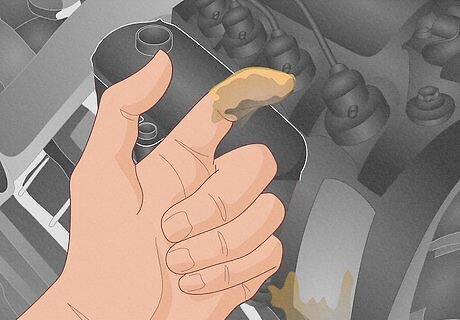
Oil leaks and discolored exhaust Lift your car’s hood. Then, check to see if you notice any oil spillage in key attachment points, seals, or gaskets. If you notice black excess oil near your engine or your exhaust pipe emits a black or blue smoke, it’s likely your oil pressure is too high and your car is overheating. If your car emits too much smoke from its exhaust, but the color looks normal, it’s likely just normal condensation and will dissipate quickly.

The “check oil” light appears The most common and least-concerning sign of high oil pressure is when your warning gauge turns on. If you see your “check oil light,” your car is detecting a pressure irregularity. This is usually the first sign you need to get your oil changed, but isn’t cause for major concern.




















Comments
0 comment